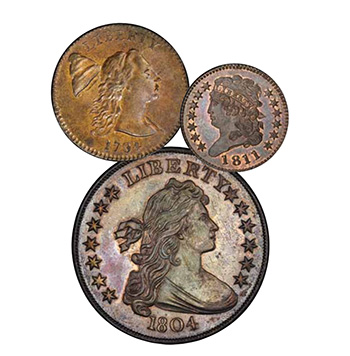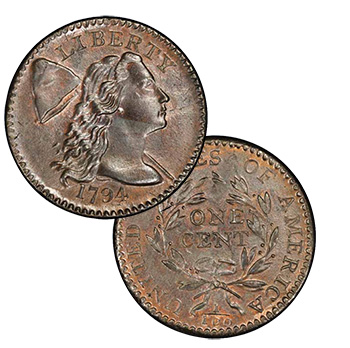By John Kraljevich – Stack’s Bowers Galleries ….
For the last two years, most of my numismatic efforts have been concentrated on the cataloging of this magnificent collection. Since these undertakings began, I’ve been reminded consistently of the good fortune I’ve had to get to know so many expert numismatists who have been happy to help, eager to share stories, and generous in offering access to their libraries and their memories. Along with a research library that has been dutifully assembled over the course of three decades, these relationships have been the sine qua non of writing the Pogue catalogs.
Half cents and large cents, collectively termed “early American copper”, compose the bulk of the present sale. They’ve also been the series that have most captured my attention over the course of my numismatic life. From the time that I was combing the flea markets of Pennsylvania for them as a boy, large cents have quickened my pulse more than any other series of United States coinage. While silver can take on a spectrum’s range of toning, and gold has a liveliness all its own, there is no other coining metal with as wide a span of inherent variation and beauty as copper. The sedate gloss of a well worn cent may not match bright red luster in most collectors’ estimation, but to those drawn to the coppers above all else, each has a distinctive appeal.
Beyond visual attractions, no other series has as long and storied a past as do the early coppers.
 Coin collecting as we know it in this country literally owes its existence to the large cent. Just as the disappearance of silver from the tills of stores from Boston to Berkeley presaged an overwhelming growth of interest in coin collecting in the 1960s, so too did the end of the large cent’s reign over pockets and countertops. The lowly cent became the coin that unified a nation of collectors in the late 1850s and the decades that followed. Before long, the finest of cabinets was defined by the finest of cents. The humble had become the most exalted.
Coin collecting as we know it in this country literally owes its existence to the large cent. Just as the disappearance of silver from the tills of stores from Boston to Berkeley presaged an overwhelming growth of interest in coin collecting in the 1960s, so too did the end of the large cent’s reign over pockets and countertops. The lowly cent became the coin that unified a nation of collectors in the late 1850s and the decades that followed. Before long, the finest of cabinets was defined by the finest of cents. The humble had become the most exalted.
Before large cents had stopped circulating, a handful of collectors realized that cents dated 1793 could depict a chain, a wreath, or a liberty cap; variety collecting has been an unstoppable force in the world of early copper. Date collections had been assembled for years before, and even today a collection of dates ranks high on many collectors’ to-do lists. But collecting by die variety has been the heart and soul of cent collecting since nearly its beginning.
The Crosby-Levick plate started the trend in 1869, identifying 15 different combinations of obverses and reverses of 1793 cents. By 1947, the works required to attribute the first decade of large cent production filled a shelf: Sylvester S. Crosby’s 1897 work on the cents of 1793 (S.S. Crosby, 1897), two books on 1794s (Frossard-Hays, 1893 and S.H. Chapman, 1926), another on the cents of 1795 through 1797 and 1800 (George H. Clapp and Howard Newcomb, 1947), one more for 1798 and 1799 (George H. Clapp, 1931), and a reference on the cents of 1801 through 1803 (Newcomb, 1925). Frossard (1879) and Doughty (1890) covered the whole series, though neither was regarded as complete in its listings or user-friendly in its execution. Still, collectors flocked to the series, and rare die varieties were avidly pursued.
And then came Sheldon.
In 1949, Dr. William Herbert Sheldon published Early American Cents. Its title page announced the collaboration of Homer K. Downing, the noted New York collector, and M.H. Sheldon, who typed the manuscript; M.H. stood for “my hands”. Sheldon, who bid with the code name “Jester” in the 1952 sale of Downing’s collection, also gave credit to Horatio and Hazard Sheldon, “who assisted with spirit”. Horatio and Hazard were the author’s typewriters. Sheldon blended a scientist’s precision with a storyteller’s playful and passionate enjoyment of the subject matter, creating a work that changed the world of numismatics far beyond the specialty about which he wrote. Sheldon invented the numerical grading standard that remains at the heart of the hobby and industry today, and his rarity scale has likewise endured nearly universally. It is certain that a book written about any other specialty but the early cents could not have produced the same pebble-in-a-pond effects as Early American Cents and its 1958 second edition Penny Whimsy did, but perhaps no author but one with Sheldon’s raconteurial gifts could have defined concepts and evoked emotions that remain so powerful today.
There is no field of American numismatics that has passed along an institutional memory and oral tradition like large cents. Many of the specialists alive today learned their love of these cents from the founding generation of the Early American Coppers Club (EAC). That generation knew Dr. Sheldon, and Dorothy Paschal, and C. Douglas Smith, and Willard C. Blaisdell and Ted Naftzger – the men and women who dominated cent collecting in the 1950s and ’60s.
Those collectors knew Homer Downing and George Clapp and Henry Hines, who knew Howard Newcomb and S. Hudson Chapman and David Proskey.
Just one more step into the past puts us face to face with the founders of American cent collecting: William Wallace Hays, Dr. Edward Maris, Charles Steigerwalt, Ed Frossard, and their mentors Sylvester Crosby, J.N.T. Levick and Joseph J. Mickley, whose curiosity about finding a cent of his birth year presaged nearly all cent collecting that followed.
 I was born two weeks after most large cent collectors got the news via Penny-Wise, the mouthpiece and heartbeat of the Early American Coppers club then and now, that Dr. Sheldon had passed away. Dr. Sheldon, who believed that genetics defined a human’s intellect and emotional state more than any other force, might have said that I was a collector even as we co-existed, he as an infirm man of nearly 80 years, me as a fetus. The generation that I learned from, that taught me to grade cents, to study their eye appeal and their provenance–and to cherish their importance and history–was the generation that learned from Dr. Sheldon himself. More than a few of my copper mentors sat next to Dr. Sheldon at the now legendary windowsill overlooking New York’s Riverside Drive, as he explained the intricacies of numerical grading and regaled them with stories of Hines, of Downing, of Newcomb and Chapman and Proskey.
I was born two weeks after most large cent collectors got the news via Penny-Wise, the mouthpiece and heartbeat of the Early American Coppers club then and now, that Dr. Sheldon had passed away. Dr. Sheldon, who believed that genetics defined a human’s intellect and emotional state more than any other force, might have said that I was a collector even as we co-existed, he as an infirm man of nearly 80 years, me as a fetus. The generation that I learned from, that taught me to grade cents, to study their eye appeal and their provenance–and to cherish their importance and history–was the generation that learned from Dr. Sheldon himself. More than a few of my copper mentors sat next to Dr. Sheldon at the now legendary windowsill overlooking New York’s Riverside Drive, as he explained the intricacies of numerical grading and regaled them with stories of Hines, of Downing, of Newcomb and Chapman and Proskey.
The stories, passion, etiquette, and fraternity that surround the large cents descended in a direct person-to-person string from the 1850s to today, creating a numismatic community like few others. It persists when copper collectors gather around a velvet tray and a bottle of scotch, but also on an online forum or a convention floor. There is something special about these coins and the people who are drawn to them, and I feel incredibly fortunate to have learned my craft while sitting at their feet. From the time I was hardly tall enough to peer into their exhibit cases, copper specialists have taken the time to share their stories and cents with me, particularly within the friendly confines of meetings of the Early American Coppers club. My efforts are offered with thanks to them.
A team of numismatists and others at Stack’s Bowers Galleries have gathered to make this effort possible:
James McCartney lent his cataloging talents to many of the Seated coins, his first work on the Pogue franchise.
John Pack, with his excellent work on the Twin Leaf Collection barely cleared from his always-busy desk, cataloged the middle and late date cents herein, dutifully tracking provenance with uncommon care. Without John’s research assistance, much of which came at what would be indecent hours were it not for the bicoastal time difference, this project would look much different.
My wife, Megan, managed to keep me sane during months of writing, caring for boys and animals while I hid behind stacks of dusty books. Like everything else I do that’s worthwhile, I couldn’t have written this without her.
The research in this and earlier Pogue catalogs was developed from decades of work by earlier authorities. The mistakes are all my own.
Apple MacBookPro Kraljevich assisted with spirit.
–John Kraljevich




